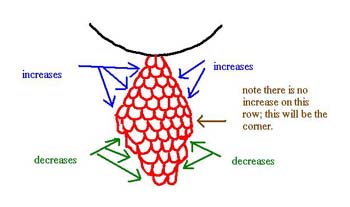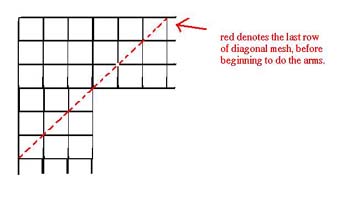
 



|
Advanced
Techniques
 Square
Mesh Square
Mesh
What if you want to make a piece of square mesh? It can
certainly be done. All mesh is worked on the diagonal,
including square mesh. That means that, to make a square
piece, you start at a corner, work outward to the widest
point, and then shrink back down to the opposite corner.
Cast on two stitches into your anchor loop. Turn and work
the second row, increasing once on the last stitch. Turn
and do the next row, and increase again. Continue like
that, working one increase at the end of each row, until
your side is the size/mesh-count that you want. On that
last row (the one that completes your mesh count), do NOT
increase on the last stitch. Just stop at the end, turn,
and start the next row.
On that next row, instead of increasing on the last
stitch, you decrease instead. Now you go as before,
decreasing at the end of each row, until you're back down
to only two completes stitches on the mesh gauge.
Turn and decrease again, combining these last two
stitches. BUT! Before you begin closing the knot, and
without dropping your shed, pull the mesh gauge OUT of
the stitch, and lay it aside (this may need a third hand,
until you're used to it). Then close your knot the same
as before, but with no loop forming. Cut the trailing
thread free.
Instead of cutting the anchor loop and pulling it out,
you're going to cut it, and tie a firm knot against your
cast on stitches. Then trim the trailing threads, and
you're done.
To do a rectangular mesh -- like an edging -- the
technique is the same. The only difference is that your
increases and decreases don't coincide. You'll be
decreasing along one edge (for as long as it takes to get
your desired length), while still increasing along the
other edge. When you get to the end, change your
increases to decreases (leaving the original decreases as
decreases), until that last corner closes. Finish as
before, and you're done.
 Handkerchief
Edge Handkerchief
Edge
A "handkerchief edge" is a conveninet name for
any square that is worked with no center. This is a very
handy pattern, which is why I include it here; it can be
used for handkerchiefs, obviously; it can also be used
for table linens, veil decorations, and more involved
structures than you would be willing to cut into a nice
piece of mondano.
Figure out how many rows of SQUARE mesh you will need to
do the darning pattern you have chosen, or to do one
inch, two inches, however deep you want the edging to be,
and figure out the meshes needed to achieve that. For
this example, we'll make it simple: let's say the pattern
I have chosen requires the edge to be ten meshes.
1. Start two meshes on your anchor loop,
and start netting, increasing at the end of each row like
a good girl, just as though you were making a square. Do
it until you have TWENTY rows -- that's TWICE the depth
of the finished edging. Now count the number of loops on
your mesh gauge; it should be twenty two, or the number
of rows plus two. Divide that number -- 22 -- by two --
11 -- and hold that number in your mind. (If your
finished edge is fifteen, then you should work thirty
rows, have thirty two meshes on the gauge, which you
would divide by two to get 16, etc. etc. etc.)
2. Pull the mesh gauge, and start the
next row, same as before. BUT!!! You're only going to go
in halfway -- eleven stitches. STOP, do not increase,
don't do anything else. Pull out the mesh gauge, and turn
around at that point. Yes, that leaves half the original
"square" untouched; don't worry, we'll get back
to it. OK, now you turn back and work back to the other
edge, where you increase, just as normally.
Turn again, do your meshes on that narrow band again, and
DECREASE in the last "inner" meshes. Keep going
like that, back and forth, increasing on the
"outside" of the row, and decreasing on the
"inside."
The "inside" side, the side you've been
decreasing on? That's the side that will actually be
touching the cloth of the handkerchief. So if you need to
certain number of meshes to do a certain pattern, THAT'S
the side you count on. That's the side you'll measure, if
you need to get it a certain length to fit your
handkerchief, whatever.
3. Now, when you get that inside bit to
the right length, number of meshes, congratulations,
you've finished Side One of your handkerchief. Now, how
to make that 90 degree turn, to do side two? You know
what? It's
so simple, I GUARANTEE you'll mess it up at least once;
you just keep expecting it to be harder than it is (I
know I have to stop and think about it every time). How
do you do it? Decrease on the "increase end"
and increase on the "decrease end." That's it.
On the side you were decreasing on? just do an increase
instead. On the side you were increasing, decrease
instead. Keep going like that, and you'll very quickly be
able to see that, while you were trying to figure out
whether you've missed a step somewhere, you've actually
done that turn and are deep into Side Two. When you get
THAT side to the right length, pull out your mesh gauge,
cut your shuttle thread, and leave it be for a while.
4. Now, to do Sides Three and Four. Go
back up to the where we started: remember those eleven
stitches I told you we'd get back to eventually? Well,
we're back. Tie back in at the OUTER edge (don't get
confused, and start on the inside, that messes up yur
count). And repeat steps 2 and 3 above, just like before.
Soon you'll have Sides Three and Four.
5. Now you've gotten to the bottom of
Side Four, and are wondering, how do you bring the whole
thing together again. Again, it's so easy, I would bet
money you'll mess it up at least once. A good tip: lay
the whole thing out, in its approximate handkerchief-ie
shape right now, so you can see it, make sure nothing is
twisted, everything's relatively correct in size, etc.
See those two bits of loose loops, at the bottom of side
Two and Side Four? Right where you're trying to figure
out how to attach the last corner, and bring the whole
thing together? We're going to work a normal row of
meshes across BOTH of them: first the one you're attached
to, then the other, in order, just as though they were
not disconnected. DECREASE at the end of the row. And
continue, just as though it were a normal square, row
after row, decreasing at the end of each row, until
you're down to those last two. Work those two together,
and Voila! You have a frame of lacis, ready to have the
handkerchief -- or whatever -- sewed into the center.
SOME
TIPS:
1. Lay the thing out often as you work
on it; it's easy to get disoriented while you're still
learning. Laying it out and looking gives you perspective
again.
2. ALWAYS count your meshes. Keep aware
of them, particularly if your pattern depends on the mesh
being only so big. Even then, it's going to get away from
you. I have yet to have a handkerchief edge come out
exactly perfect. You learn to adjust.
3. I usually try to put the cloth into
the center BEFORE I stretch it on the frame to be darned.
It just makes stretching easier, because that hole,
unfilled, wants to distort, which robs me of good frame
tension. However, I know people who swear by stretching
it first, then fitting the cloth. Try it both ways, see
which one works better for you.
4. This is not restricted to perfect
squares; rectangles can be done the same way; as long as
the corners are 90 degrees, the length of the sides is
not relevent to how to work is done. For that matter,
this sort of thing does not have to be the outer edge of
a project. You can do it as an inset for a larger piece,
like a tablecloth. Do it the same as always, but you
attach the cloth to the outer edge as well as the inner
edge.
[The
information and images on this website are Copyright of
Lady Cecilia Bartoletti (June). You may make a copy and
use any information contained herein for personal use
only, or for SCA documentation purposes. Unauthorised
publication is not permitted.]

|